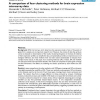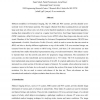356 search results - page 30 / 72 » Polyrhythm in the Human Brain |
KDD
2001
ACM
14 years 9 months ago
2001
ACM
During the last decade, the area of bioinformatics has produced an overwhelming amount of data, with the recently published draft of the human genome being the most prominent exam...
Publication
Human eyes are highly efficient devices for scanning through a large quantity of low-level visual sensory data and delivering selective information to one’s brain for high-level...
IPMI
2005
Springer
14 years 9 months ago
2005
Springer
Modeling the variability of brain structures is a fundamental problem in the neurosciences. In this paper, we start from a dataset of precisely delineated anatomical structures in ...
BMCBI
2008
13 years 8 months ago
2008
Background: DNA microarrays, which determine the expression levels of tens of thousands of genes from a sample, are an important research tool. However, the volume of data they pr...
BIBE
2001
IEEE
14 years 10 days ago
2001
IEEE
Different modalities in biomedical imaging, like CT, MRI and PET scanners, provide detailed crosssectional views of the human anatomy. The imagery obtained from these scanning dev...


